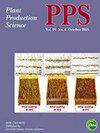Status quo and challenges of rice production in sub-Saharan Africa
IF 1.3
3区 农林科学
Q2 AGRONOMY
引用次数: 1
Abstract
ABSTRACT Rice production in sub-Saharan Africa (SSA) has increaed ten-fold since 1961, whereas its consumption has exceeded the production and the regional self-sufficiency rate is only 48% in 2020. Increase in rice production has come mainly from increased harvested area. Yield increase has been limited and the current average yield in SSA is around 2 t ha−1. This paper aims to provide the status quo of (i) current rice production and its challenges, (ii) selected achievements in rice agronomy research mainly by the Africa Rice Center and its partners, and (iii) perspectives for future research on rice agronomy in SSA. The major problems confronting rice production include low yield in rainfed environments, accounting for 70% of the total rice harvested area. Rainfed rice yields are strongly affected by climate extremes such as water stresses, soil-related constraints, and sub-optimum natural resource management and crop management practices by smallholder farmers including poor water management, and suboptimal use of fertilizers, herbicides, and machineries. For alleviating these constraints, a wide range of technologies have been developed and introduced over the last three decades. These include water conservation technologies in rainfed and irrigated lowland rice, site-specific nutrient management practices, decision support tools such as crop growth simulation models, and labor-saving technologies. We conclude that further research efforts are needed to develop locally adapted agronomic solutions for sustainable intensification, especially in rainfed rice to enhance the resilience to climate change and increase land and labor productivity and sustainability of rice cultivation in SSA. GRAPHICAL ABSTRACT撒哈拉以南非洲水稻生产的现状和挑战
自1961年以来,撒哈拉以南非洲(SSA)的水稻产量增长了10倍,但其消费量超过了产量,2020年该地区的自给率仅为48%。水稻产量的增加主要是由于收获面积的增加。产量增长有限,目前SSA的平均产量约为2 t ha - 1。本文旨在提供(i)当前水稻生产现状及其面临的挑战,(ii)主要由非洲水稻中心及其合作伙伴在水稻农学研究方面取得的成就,以及(iii)对未来SSA水稻农学研究的展望。水稻生产面临的主要问题包括雨养环境的低产量,占水稻总收获面积的70%。旱作水稻产量受到极端气候的严重影响,如水资源紧张、与土壤有关的制约因素,以及小农的自然资源管理和作物管理实践不理想,包括水资源管理不善,以及化肥、除草剂和机械使用不理想。为了减轻这些限制,在过去的三十年中已经开发和引入了广泛的技术。这些技术包括旱作和灌溉低地水稻的节水技术、特定地点的养分管理实践、诸如作物生长模拟模型等决策支持工具以及节省劳动力的技术。我们认为,需要进一步研究开发适合当地的可持续集约化农艺解决方案,特别是在旱作水稻方面,以增强对气候变化的适应能力,提高南撒哈拉地区水稻种植的土地和劳动生产率和可持续性。图形抽象
本文章由计算机程序翻译,如有差异,请以英文原文为准。
求助全文
约1分钟内获得全文
求助全文
来源期刊

Plant Production Science
农林科学-农艺学
CiteScore
5.10
自引率
4.00%
发文量
27
审稿时长
>36 weeks
期刊介绍:
Plant Production Science publishes original research reports on field crops and resource plants, their production and related subjects, covering a wide range of sciences; physiology, biotechnology, morphology, ecology, cropping system, production technology and post harvest management. Studies on plant production with special attention to resource management and the environment are also welcome. Field surveys on cropping or farming system are also accepted. Articles with a background in other research areas such as soil science, meteorology, biometry, product process and plant protection will be accepted as long as they are significantly related to plant production.
 求助内容:
求助内容: 应助结果提醒方式:
应助结果提醒方式:


